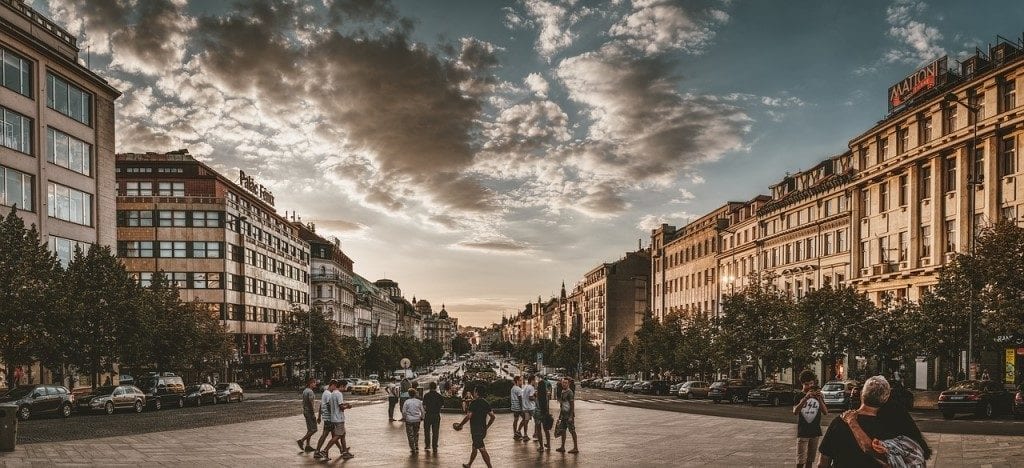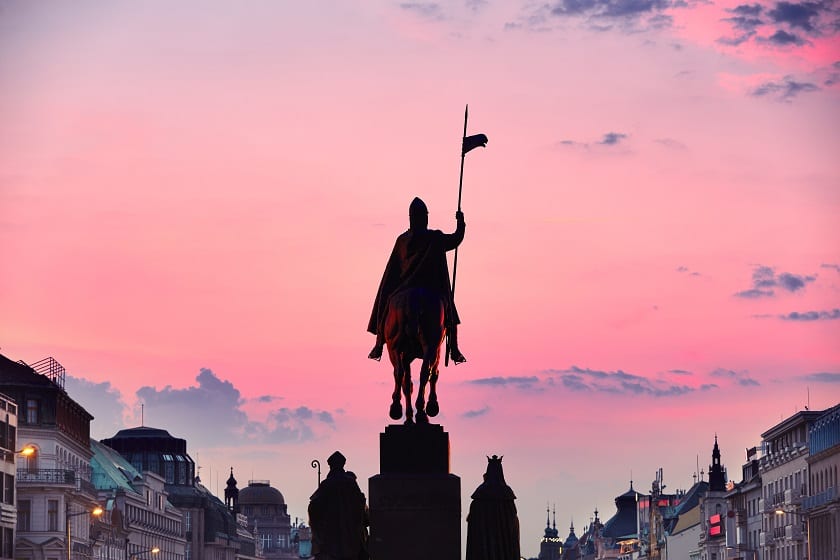
Wenceslas Square is the second biggest square in the Czech Republic and one of the most sought-after and busiest places in the metropolis. It is situated in the Prague 1 municipal district, in the New Town. It is 750 metres long, with the National Museum and the equestrian statue of St Wenceslas dominating the square. Wenceslas Square is a cultural and business centre of Prague.
History
Formerly known as the Horse Market, Wenceslas Square was the main scene of significant historical and political events in Czech history in the 20th century. In 1918, the reading of the declaration of an independent Czechoslovakia took place there. At the end of World War II, several local houses were demolished during the Prague uprising and later replaced by shopping centres. During the 1968 Soviet occupation, the National Museum was damaged by a military attack. In 1969, student Jan Palach burnt himself to death in the upper part of the square as a protest against the occupation. During the Velvet revolution in November 1989, Wenceslas Square became the main venue for demonstrations that led to the fall of the communist regime.
Places to see in Wenceslas Square
National Museum
The neo-Renaissance building of the National Museum is the dominant feature of Wenceslas Square. The building was damaged several times during the stormy historical events that took place in Wenceslas Square.
Other museums
The Cold War Museum is also located on Wenceslas Square. The Náprstek Museum of Asian, African and Native American art is located a short distance away on the Bethlem Square.
Equestrian statue of St Wenceslas

Every visitor to Prague should visit the statue of St Wenceslas, the patron saint of Bohemia and Moravia. The equestrian statue is situated below the National Museum and symbolizes the Czech statehood.
Historical hotels
There are several interesting historical hostels on Wenceslas Square – Ambassador, Evropa and Zlatá husa.
Lucerna Palace and other palaces
The Lucerna Palace, a national cultural monument, is a complex of buildings that, among others, include the Rococo Palace and the Ice Palace on Wenceslas Square. These two building are also known as the Šupich Houses.
Other historical monuments
There are a number of interesting palaces from different periods – the Art Nouveau Koruna Palace represents the early 20th century. The U Stýblů Palace symbolizes the 1920s and 1930s and the Euro Palace represents modern architecture.
Culture in Wenceslas Square
There is a great concentration of theatres in the area around Wenceslas Square. The Rokoko theatre specializes mainly in comedies. Other theatres include, for example, the Palace Theatre and the Studio DVA theatre.
Worth mentioning is also the Great Hall of the Lucerna Palace, where lectures, concerts and other cultural events take place.
Night life
Nebe coctail & music bar, COMO restaurant & coctail bar and Da Capo are favourite clubs on Wenceslas Square.
Where to eat
The Italian snack bar Da Tarquinio prepares dishes only from ingredients imported directly from Italy. Tapas Room restaurant serves Spanish dishes. Husinec restaurant specializes in ducks and other Czech dishes.
Veget Bistro Café is a perfect choice for vegans and vegetarians. Loving Hut offers mainly Asian meals. George Prime Burger is a restaurant that offers a wide selection of burgers as well as vegan meals.
There are also the following fast food restaurants on Wenceslas Square: McDonald’s, KFC, Costa Coffee and Starbucks.
Coffee
Šachový Václavák café offers a very quiet environment, which is quite unusual for the centre of Prague. The café tries to follow on the tradition of the former Juliš café, which operated on the site before WWII. There are books, magazines and a chess game available for guests.
The modern Oliver’s Coffee Cup caféserves fresh desserts, ice drinks and coffee. Saint Tropez confectionery is well worth visiting for its delicious ice cream, cakes and desserts.